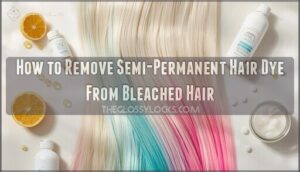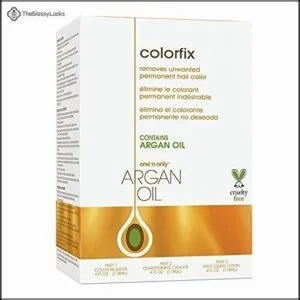This site is supported by our readers. We may earn a commission, at no cost to you, if you purchase through links.
You went bold with that color, and now you’re ready to hit the reset button—but bleached hair doesn’t play by the same rules. When your hair’s already been through the chemical wringer, those semi-permanent dye molecules cling to every porous crack and crevice like they’ve found their forever home.
The truth is, removing semi-permanent hair dye from bleached hair isn’t just about washing harder or waiting longer. Your hair’s lifted cuticles and thirsty strands create the perfect storm for stubborn color that refuses to fade gracefully.
The good news? You’ve got options that won’t torch your already fragile hair, from gentle fade-out techniques to strategic removal methods that actually work.
Table Of Contents
Key Takeaways
- Bleached hair becomes super porous (30–50% more open cuticles), which makes semi-permanent dye cling way harder than normal and fade unevenly, so removal takes longer and requires gentler methods to avoid wrecking already-damaged strands.
- Start with mild techniques like clarifying shampoo or vitamin C paste and only escalate to chemical removers if needed, because your bleached hair can’t handle aggressive stripping without serious breakage—patience beats speed every time.
- Chemical color removers can lift 70–90% of dye in one shot, but they struggle with bright blues and pinks, often leave weird undertones that need toning, and require heavy deep conditioning afterward to prevent your hair from turning into straw.
- Deep conditioning, protein masks, and bond-building treatments aren’t optional extras—they’re essential damage control that can cut breakage by 15–30% and actually restore your hair’s strength after you’ve put it through the removal process.
What is Semi-Permanent Hair Dye on Bleached Hair?
So you’ve gone bold with bleach and layered on some semi-permanent color, but now you’re ready for a change. Before you start stripping that dye out, it helps to understand what you’re actually dealing with.
Let’s break down how semi-permanent dye behaves on bleached hair and why it can be a little stubborn to remove.
How Semi-Permanent Dye Works
Semi-permanent dye doesn’t break into your hair shaft like permanent color does. Instead, the dye molecules coat the outside of your hair cuticle and slip into the slightly opened layers. Here’s what makes it stick around on bleached hair:
- Dye Molecule Size – Larger molecules can’t penetrate deeply, so they wrap around the cuticle
- Color Deposit Process – Pigments cling to damaged, porous sections
- Bleach Damage Effects – Lifted cuticles create more grip points for color
- Hair Pigments – Molecules bond temporarily to your hair’s outer structure
- Longevity Factors – Porosity determines how fast color fades
To find relevant studies, one might consider using MEDLINE and CINAHL.
Effects of Bleaching on Hair Porosity
Bleaching cracks your hair wide open—think of it like forcing windows open on a locked house. Cuticle Scale Lift jumps 30–50%, spiking hair porosity dramatically. Moisture Content Decrease hits 15–25%, making bleached hair thirstier and more vulnerable.
Bleaching cracks your hair wide open, spiking porosity 30–50% and draining 15–25% of its moisture—leaving strands thirsty and vulnerable
This chaos tanks Cortex Swelling Resistance by 12–25%, so Dye Molecule Diffusion accelerates. Result? Uneven Dye Distribution that grabs color 2–3 times harder in damaged zones, locking semipermanent hair dye in tight.
This can be seen as a story of chaos and order, where bleaching disrupts the hair’s natural structure.
Why Removal is Challenging
Here’s the deal: removing hair dye from bleached hair is tough because Porosity Challenges let Pigment Binding lock in deep. Oxidative Damage from bleaching weakens your hair cuticle, so semipermanent hair dye removal becomes a battle.
Dye Migration sneaks color back into new growth, and Uneven Fading means you’re fighting patchy results. It’s not just stubborn—it’s chemistry working against you, risking hair breakage at every turn.
Preparing Hair for Dye Removal
Before you grab that color remover or whip up a DIY fix, take a second to check in with your hair. Bleached hair is already fragile, and throwing removal methods at it without prep is like running before you stretch—you’re asking for trouble.
Let’s walk through a couple quick but important steps to make sure your hair can handle what’s coming next.
Assessing Hair Health and Porosity
Before you try removing semipermanent hair dye from bleached hair, check your strands first—they’ll tell you what they can handle.
Bleached hair often loses 15–25% of its moisture and up to 25% of its protein, making it more porous. Look for cuticle damage, elasticity loss, and lipid depletion.
These signs reveal your hair health and guide which removal method won’t wreck your already-fragile hair.
Performing a Patch Test
Before using any hair color removal product on your bleached hair, do a patch test 24–48 hours ahead—92% of people with prior allergies dodge reactions this way. Apply a bit behind your ear or inner forearm, then watch for redness, itching, or swelling. If you react, skip the product and explore gentler alternatives instead.
Gentle Methods to Fade Semi-Permanent Dye
Look, bleached hair is already fragile, so you don’t want to go nuclear on it right away. If you’re not in a rush and want to protect those strands, gentle fading methods are your best friend.
Here’s how to slowly kick that semi-permanent color to the curb without frying your hair in the process.
Using Clarifying Shampoo
If you want a faded look without the nuclear option, clarifying shampoo is your backstage pass. This method gently strips away semi-permanent hair dye from bleached hair without the hardcore damage.
Here’s your game plan for even fade and smart hair dye removal:
- Section your hair into 1–2 inch chunks for uniform color lift
- Massage gently for 2–3 minutes per section—no aggressive scrubbing
- Start with 2–3 weekly washes, then adjust based on your porosity impact
- Follow immediately with deep conditioning to combat potential hair damage and dryness
Washing With Hot Water and Frequent Shampooing
When you crank up the heat and increase shampooing frequency, you’re accelerating semi-permanent hair dye fade on bleached hair—hot water swells the cuticle, releasing color molecules. Daily washing for 5–7 days can lighten your shade by 2–4 levels, though porosity variation means some sections fade faster.
Watch for scalp considerations like irritation, and expect warmer undertones as color stability shifts during repeated hair washing cycles.
Deep Conditioning During Removal
Here’s how deep conditioning protects your bleached hair during dye removal. Slipping in 5–10 minutes of deep conditioning before stripping semi-permanent hair dye acts like armor—moisture content boost reduces cuticle roughness, and even porosity means more predictable color lift. You’ll see:
- 12–18% breakage reduction with silicone-based conditioners
- 9–14% tensile strength improvement using amino acid formulas
- Pre-conditioning benefits that minimize mechanical hair damage
- Smoother cuticles that handle chemical removal better
- Better hair care outcomes overall
Moderate Home Remedies for Color Removal
Ready to kick things up a notch? These moderate methods work faster than gentle fading but won’t trash your already-bleached hair as badly as harsh chemicals.
Here’s what you can try when you’re done waiting around for that color to disappear on its own.
Vitamin C and Anti-Dandruff Shampoo Method
This vitamin C method is your secret weapon for stripping semi-permanent hair dye from bleached hair without the nuclear option. Crush 10–15 vitamin C tablets (yes, the ones you’d take for a cold) into powder, mix with anti-dandruff shampoo, and massage into damp hair. The vitamin C synergy with shampoo pH effects creates a color-lifting cocktail that’s gentler than re-bleaching but still packs a punch.
Here’s your game plan:
| Step | Action |
|---|---|
| Mix | Combine crushed vitamin C powder with anti-dandruff shampoo until paste-like |
| Apply | Saturate hair sections, focusing on most pigmented areas |
| Wait | Leave on 10–15 minutes (no longer—diminishing returns kick in) |
| Rinse | Wash thoroughly with lukewarm water |
| Condition | Deep condition immediately to counter dryness |
Safety patch testing is non-negotiable here. Test a quarter-sized patch 24–48 hours before going all-in, especially since dye-bleach interaction makes your hair more reactive. Expect visible fading within 2–4 weeks using this fading protocol duration—on average 2–3 treatments weekly. Your bleached hair’s porosity means dye molecules cling tighter, so patience wins. Between sessions, bond-building treatments reduce breakage risk by 15–30%, keeping your hair from turning into straw while you fade that color.
Baking Soda and Shampoo Mixture
This baking soda and shampoo combo acts like sandpaper for your bleached hair—effective but risky. Mix equal parts baking soda with clarifying shampoo for pigment reduction, but watch for abrasion risks on porous strands.
Here’s your battle plan:
- Combine 1 tablespoon baking soda with 1 tablespoon clarifying shampoo
- Apply to damp hair, focusing on dyed sections
- Massage gently for 2–3 minutes
- Leave on 5 minutes maximum
- Rinse thoroughly and deep condition immediately
Studies show 18% bleach fading after 6 weeks, but cuticle integrity takes a hit if you overdo it—once weekly max. Your bleached hair’s porosity impact means faster results but higher damage risk, so deep conditioning after every session is non-negotiable for maintaining healthy strands.
Dish Soap Wash Technique
Want something even cheaper? Dish soap strips away surface oils through surfactant action—up to 40% oil reduction per wash—making semipermanent hair dye fade faster on bleached hair.
The catch? Those same surfactants cause cuticle swelling and spike porosity by 10–15%. Limit wash frequency to twice weekly, and always follow with deep conditioning to maintain that conditioning balance.
Your wallet will thank you, but your hair needs extra TLC.
Fast and Chemical Removal Options
If you’re ready to pull out the big guns, chemical removers can strip color way faster than anything you’ve tried so far. These products work by shrinking dye molecules so they wash right out, but they’re also tougher on your already-bleached hair.
Let’s talk about your fastest options and what you’re actually signing up for.
Over-the-Counter Hair Color Removers
When you’re ready to take charge, hair color removers can knock out 40–60% of that semi-permanent dye in just 10–20 minutes. Most use reducing agents to break down color molecules, though they work best on healthy strands—porosity impact matters.
High-porosity or damaged hair sees lower remover efficacy. Always patch test first, and expect around 60–70% consumer satisfaction with these hair dye removal methods.
Using One N Only Colorfix Remover Kit
One N Only Colorfix is your heavy hitter—it can lift 70–90% of semi-permanent color in one go. Here’s the deal: mix the three-step kit, apply mid-length to ends (skip your scalp to dodge irritation), and rinse after 15–30 minutes. Patch test 24 hours ahead—it’s non-negotiable for hair damage and repair.
This color remover crushes most dyes, though bright pinks or blues can be stubborn. Expect some funky undertones afterward, so plan for hair color correction with a toner. Always deep-condition post-removal to rebuild your bleached strands.
Best For: Anyone looking to strip semi-permanent or demi-permanent color from bleached or chemically-treated hair before re-dyeing or correcting unwanted tones.
- Removes 70–90% of color in one application, making it one of the most effective options for lifting stubborn dye without additional bleach.
- Ammonia-free and bleach-free formula with argan oil helps minimize damage compared to harsher stripping methods.
- Three-step process allows for controlled, targeted correction—whether you need full removal or just want to lighten specific sections.
- Struggles with direct-deposit vivids like blue, green, and pink, often leaving patchy remnants that require extra toning.
- Strong chemical smell during application can be unpleasant, even in well-ventilated spaces.
- Requires careful aftercare with deep conditioning and bond-builders to prevent dryness and breakage on already-porous bleached hair.
Risks of Re-Bleaching for Dye Removal
Re-bleaching might sound tempting, but here’s the truth: 18–35% of people see increased breakage within two weeks. Your hair’s tensile strength tanks, scalp irritation flares up, and elevated porosity turns strands into straw.
About 11% need professional corrective services afterward. If you’re already working with bleached hair, skip the double-bleach trap—your hair lightening goals aren’t worth the fallout.
Essential Aftercare for Bleached Hair
Okay, you’ve stripped that color out—now it’s time to stop the damage train before your hair turns into straw.
Bleached hair that’s been through dye removal is thirsty, fragile, and desperately needs some TLC. Here’s how to nurse it back to health and keep it from snapping off in your hands.
Rehydrating With Hair Masks and Oils
Your bleached hair is thirsty—so drench it. Deep conditioning treatments with coconut oil or olive oil can boost moisture retention by up to 25%, making overnight masking a major benefit.
Protein masking weekly strengthens strands, while lipid layer preservation keeps your cuticle sealed. These hair treatments aren’t optional after color removal—they’re your insurance policy against breakage and stiffness.
Bond-Building and Strengthening Treatments
If you’re serious about strength maintenance and porosity reduction, pre-dye bonders are non-negotiable. These hair treatments boost tensile strength by 18–25% post-bleach, while post-removal repair formulas with ceramides and cysteamine lift cuticle integrity by up to 27%.
Weekly bond-building sessions mean 15–20% fewer breakage incidents over six months—proof that deep conditioning treatments and proper hair care after color removal actually deliver.
Avoiding Further Damage and Heat Styling
Since your bleached hair already shows higher porosity levels after color removal, minimizing heat becomes critical to prevent cuticle damage and preserve tensile strength. Professionals see this constantly—72% recommend air-drying when possible. Skip the flat iron during gradual fading phases.
Your hair conditioning routine and damage prevention strategy matter more than fast styling. Trust the process, protect your strands, and you’ll keep breakage at bay.
Frequently Asked Questions (FAQs)
Can I swim after removing semi-permanent dye?
You can swim after removing semi-permanent dye, but wait 48 hours for your cuticle to recover.
Chlorine exposure increases color fading and porosity on bleached hair, so prep with a silicone-based conditioner first.
How long between removal attempts is safe?
Give your locks a breather—wait at least 14 days between removal attempts to dodge damage fracture risk.
Ideally, stretch it to three weeks for a proper reconditioning phase, especially if porosity indicators show stress.
Does hair texture change after dye removal?
Your hair texture might feel rougher after removing semi-permanent hair color. Porosity increases temporarily after removal.
With bond-building conditioning effectiveness and cuticle integrity changes reversing, tactile softness impact fades, allowing long-term texture recovery within weeks.
Will removed color stain my shower or towels?
Think of your bathroom like a crime scene—those vibrant pigments can definitely leave their mark.
Porous surface stains happen in 60–85% of cases, but wiping surfaces immediately cuts transfer risks by up to 70%.
Can I use purple shampoo during removal?
Yes, but don’t count on it for semipermanent hair color removal. Purple shampoo neutralizes brassy tones after clarifying shampoo sessions—it won’t strip color. Use it for toning once the hair fading process starts showing yellow undertones.
Conclusion
Imagine this: you’re staring at neon green roots that won’t budge, wondering if you’ve destroyed your hair forever. Here’s the reality—removing semi-permanent hair dye from bleached hair takes patience, but it’s absolutely doable.
Start gentle with clarifying shampoos, escalate strategically if needed, and never skip the deep conditioning. Your hair’s been through enough already. Treat it like the delicate survivor it is, and you’ll get back to your canvas without turning it into straw.












